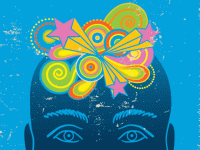Brain Movies: When Readers Can Picture It, They Understand It
Your content has been saved!
Go to My Saved Content.The images that form in your mind as you read -- we call them "brain movies" -- can be more exciting and memorable than a Hollywood film. More to the point for teachers, guiding your students to visualize as they read is an engaging and enjoyable way to boost comprehension and retention.
Learning to create brain movies can help students make sense of complex nonfiction subject matter and "see" the characters, setting, and action in stories. Teachers who use our strategy tell us their students seem to have more fun -- and success -- as they read. These anecdotes are supported by research showing that students who are taught to develop mental imagery of text do better than control groups on tests of comprehension and recall.
The research basis for the usefulness of transforming text into mental images can be found in Allan Paivio's dual coding theory, which holds that cognition consists of both a verbal system for language and a nonverbal, visual-spatial one for images. By creating mental images from the words on a page or screen, we tap into both the verbal and visual-spatial representational systems, making abstract concepts more concrete and thus more meaningful and memorable.
From Text to Brain Movies
Visualizing while reading is a strategy that should be explicitly taught. The assumption that children are naturally imaginative may not be true for all students, and even those with vivid imaginations may need guidance in applying the active process of making brain movies to improve their understanding of what they read. Follow these steps to introduce brain movies to your students:
- Select a book, poem, or reading passage with vivid, sensory-rich language to read aloud.
- Introduce words or concepts that may be new to students before reading, and share photographs, websites, and other images to help set the stage.
- Ask students to share examples of movies based on books they've read, and lead a discussion about the difference between reading the book and watching the movie. Emphasize that as we read or are read to, our imagination creates its own brain movie.
- Recommend that as you read the selected passage, students create their own brain movies based on the text by imagining the characters, setting, and action. Suggest that some students may find it easier to visualize if they watch you as you read, close their eyes, or gaze out the window.
- Read with inflection and emphasis on striking language.
- When you are done reading, pause to let students finish translating the text into brain movies. Then ask for volunteers to share their favorite imagery or scene.
- Discuss how students' experiences helped them relate to the story and create their brain movies. How are the characters like them or people they know? How are they different? How is the setting of the story similar to and different from their neighborhoods and places they have visited?
- Note how many people find that visualizing what they read helps them to understand and remember the subject matter.
- Encourage students to continue conjuring movies in their minds as they read. Emphasize that creating brain movies requires reading carefully and attentively. And suggest that if they have a hard time visualizing a passage, they should reread it and look up any unfamiliar words.
Examples of Brain Movies in Action
Teachers who've used this strategy in their classrooms share these examples and tips for enhancing its effectiveness:
Share Brain Movies to Extend the Learning
Florida teacher Kelly Rose introduced brain movies to a literature circle of fifth graders, beginning with the powerful language of poetry. After guiding students to picture the images in their minds as they read and reread the poems, Ms. Rose then asked them to share what they visualized. "We found that our brain movies were all different, and by sharing our movies, we were able to remember even more details from the poem," she says.
Emphasize Vivid Language for Young Writers
Working with elementary students learning English as a second language, Georgia teacher Melissa Smith shares reading passages that demonstrate how writers choose their words carefully to help readers create brain movies. She then guides students to picture their own stories in their minds as they write, which helps identify the details and striking language that will tell their stories most effectively.
Let Students Choose Their Own Material
Giving students a choice in what they read can make it easier to teach how to create mental imagery. They are more likely to be engaged in and derive meaning from reading they enjoy.
For Further Reading
For more details and examples on using brain movies in your classroom, see author Donna Wilson's 2012 article (doi: 10.1002.TRTR01091) in The Reading Teacher (available by subscription, perhaps through your school or district). Mark Sadosky's article Mental Imagery in Reading summarizes some of the research supporting this strategy. For more visual strategies to support meaning making and retention, see our book BrainSMART: 60 Strategies for Increasing Student Learning.
How might brain movies support other reading comprehension strategies for your students?
